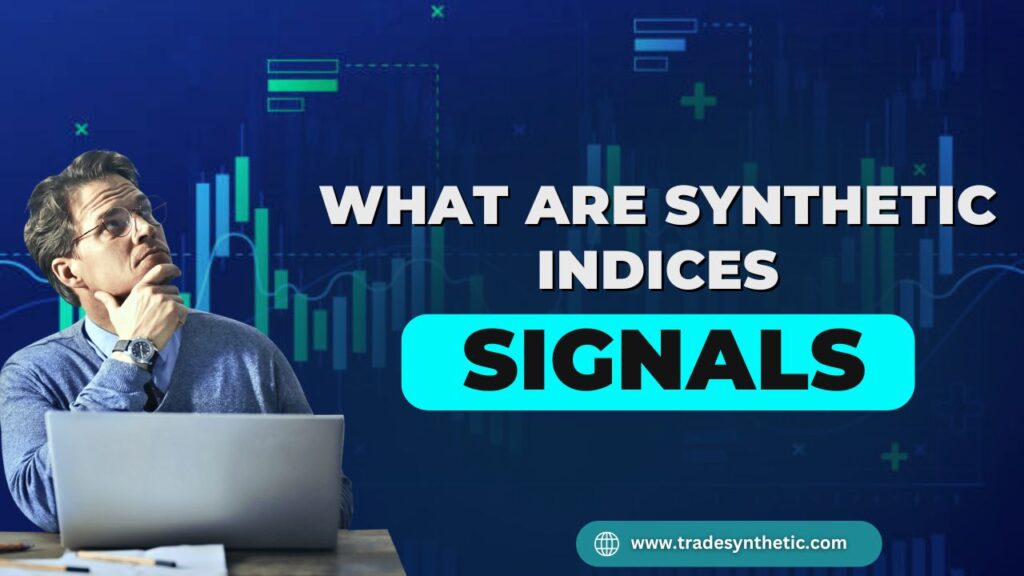Traders often rely on synthetic indices signals because of how synthetic indices have gained attention from traders around the globe. These signals help traders make informed decisions and guide traders on when to enter or exit trades, manage risks, and maximize profits.
In this article, we’ll explore what synthetic indices signals are, how they work, and why they are essential for traders. We’ll also cover where to find reliable signals and how to use them effectively.
What Are Synthetic Indices Signals?
Synthetic indices signals are alerts or recommendations that help traders decide when and how to trade synthetic indices. These signals are generated using:
- Technical analysis tools like charts and indicators.
- Algorithmic programs designed to track market patterns.
- Expert opinions based on market trends.
They provide information such as:
- Buy or sell recommendations.
- Stop-loss and take-profit levels.
- Expected price movements.
Why Are Signals Important?
Signals are very important in trading synthetic indices because they help traders make well-informed decisions, improve accuracy, and save time. Let’s see why signals are essential:
1. Provide Clear Trading Guidance
Signals offer actionable insights on when to enter or exit a trade, helping traders avoid guesswork. This is especially useful for beginners who may not yet fully understand technical analysis or market trends.
2. Improve Decision-Making
Trading can be overwhelming due to constantly changing market conditions. Signals simplify the process by filtering essential information, enabling traders to make faster and more confident decisions.
3. Save Time and Effort
Analyzing markets manually can take hours. Signals, especially those generated by algorithms, provide real-time updates, saving traders significant time.
4. Enhance Accuracy
High-quality signals are often generated using advanced tools and expert analysis, reducing the likelihood of human errors. They also combine multiple indicators, which helps confirm trends and minimizes false signals.
5. Assist in Risk Management
Signals often come with predefined stop-loss and take-profit levels, helping traders manage their risks more effectively. This prevents impulsive decisions and protects capital during volatile market conditions.
6. Help Beginners Get Started
For new traders, signals serve as a guide to understand the market better. By following reliable signals, they can learn how professionals approach trading and gradually develop their skills.
7. Optimize Trading Strategies
Experienced traders use signals to refine and validate their strategies. They act as an additional layer of confirmation for trade setups, ensuring that the strategies align with market conditions.
How Do Synthetic Indices Signals Work?
- Technical Indicators
Most synthetic indices signals are based on technical indicators. As a matter of facts, Signals are often a combination of multiple indicators to confirm trends and reduce false alerts. Commonly used indicators include:
- Moving Averages (MA): These helps identify trends.
- Relative Strength Index (RSI): Shows overbought or oversold conditions.
- Bollinger Bands: Highlight volatility and potential breakouts.
2. Algorithmic Tools
Advanced tools use machine learning and algorithms to analyze market data and generate precise signals. These tools scan the market continuously to provide real-time updates.
3. Human Expertise
Some signals come from experienced traders or analysts who interpret market trends and provide personalized recommendations.
Types of Synthetic Indices Signals
a. Buy and Sell Signals
These indicate when to enter (buy) or exit (sell) a trade. They are often accompanied by a recommended price level.
b. Trend Signals
These signals help identify whether the market is trending upward, downward, or sideways. Traders can use them to align their strategies with the current market trend.
c. Volatility Signals
Synthetic indices often have fixed levels of volatility. Volatility signals indicate periods of high or low market activity, allowing traders to adjust their strategies accordingly.
d. Breakout Signals
Breakout signals alert traders when the price breaks through support or resistance levels, indicating potential large price movements.
Where to Find Synthetic Indices Signals
a. Signal Providers
Many platforms and traders offer synthetic indices signals. One good example is Deriv’s MT5 Platform which includes built-in tools for signal generation.
b. Social Media and Forums
You can join our Telegram – https://t.me/tradesynthetic
Automated Trading Tools
Bots and software can generate signals automatically based on predefined algorithms.
d. Professional Traders
Some experienced traders offer subscription-based signal services, providing tailored recommendations.
How to Use Synthetic Indices Signals Effectively
a. Understand the Signal
Before acting on a signal, ensure you understand the logic behind it. Study the technical indicators or analysis it is based on.
b. Combine with Personal Analysis
While signals are helpful, they shouldn’t replace personal research. Use them as a guide alongside your trading strategies.
c. Test on a Demo Account
If you’re unsure about a signal, test it on a demo account to see how it performs without risking real money.
d. Monitor Your Trades
Even with reliable signals, market conditions can change quickly. Keep an eye on your trades to adjust as needed.
e. Manage Risks
Always use stop-loss and take-profit levels to protect your account. Avoid over-relying on signals and risking too much on a single trade.
Conclusion
Synthetic indices signals play a crucial role in helping traders make informed decisions. They simplify trading by providing actionable insights based on market trends, technical indicators, and expert analysis. However, it’s essential to use these signals wisely by combining them with personal research and sound risk management.
Whether you’re a beginner looking to start trading or an experienced trader seeking additional guidance, signals can be a valuable tool when used effectively. Explore different providers, test their reliability, and always prioritize understanding the market.
Frequently Asked Questions
What are synthetic indices signals?
- Synthetic indices signals are recommendations or alerts that help traders decide when to buy or sell synthetic indices. They are generated using technical analysis, algorithms, or expert opinions.
Are synthetic indices signals reliable?
- The reliability of synthetic indices signals depends on the provider. Signals from verified platforms or experienced traders tend to be more accurate. Always do your research before trusting a signal.
Where can I get free synthetic indices signals?
- You can find free signals on social media platforms, forums, or some trading apps. However, exercise caution and verify the provider’s credibility.
How do I use synthetic indices signals effectively?
- Understand the logic behind the signal, combine it with your analysis, test it on a demo account, and always manage your risks with stop-loss and take-profit orders.
Do I need synthetic indices signals to trade?
- While signals can be helpful, they are not mandatory. You can trade successfully by learning technical analysis and developing your strategies.










